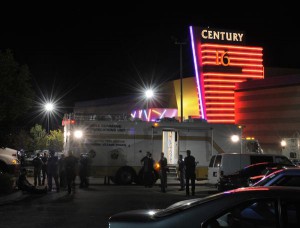The Massacre That Almost Was, and the Hero Who Stopped It
A Forgotten Hero, Remembered
 In a world where acts of violence and public standoffs with guns and hostages are now tragically commonplace, the names and locations have become permanent touchstones for a cultural disintegration. Jonesboro. Virginia Tech. Moses Lake. Fort Hood. Aurora. Klebold and Harris. Seung-Hi Cho. Nidal Hasan. James Holmes. Columbine.
In a world where acts of violence and public standoffs with guns and hostages are now tragically commonplace, the names and locations have become permanent touchstones for a cultural disintegration. Jonesboro. Virginia Tech. Moses Lake. Fort Hood. Aurora. Klebold and Harris. Seung-Hi Cho. Nidal Hasan. James Holmes. Columbine.
Columbine.
15-years after the fact, even as the nation mourns the latest episode of public massacre, it is still the name that’s become an adjective for a brand of unthinkable evil that defies description. We hear the words on a hundred newscasts from a thousand different lips. A Columbine-style attack. Columbine-style. As one of the earliest, and still, deadliest examples in this macabre era of high school violence, (only the Virginia Tech shooting saw more deaths) Columbine commands a place of special mourning in the American soul. The headlines forever etched in our minds: 2 Gunmen. Multiple Weapons. 14 People Killed. A Nation in Shock. Columbine-style.
Columbine-style. A beautiful, blue-purple flower, forever linked to an indelible scar.
What you may not know or remember is that it was almost a Pasque flower, instead. And on September 11th, 1991, it almost became Rapid City-style, instead. Almost.
That’s the day when another picturesque American city came very, very close to being branded with that infamous and unfortunate adjective seven years before Columbine High School in Littleton, Colorado. In Rapid City, South Dakota, a place where the native purple flower is the prairie Pasque instead of the Columbine, people remember just how close they came to writing the national headlines: One Gunman. 22 People Killed. A Nation in Shock. Rapid City-style. But for the actions of one heroic young man, it just might have turned out that way.
 For four hours on that September day, 17-year old Ryan Harris held 22 of his fellow students hostage inside a locked classroom with a sawed off shotgun. For four hours, he blared messages over the public address system, demanded pizza and cigarettes, asked for $1-million dollars, and a helicopter to make his getaway. With the full attention of a community, a school and a police force, Harris fired his weapon ten times, hitting no one. He was playing games, using the gunshots to underscore his demands, and each time underscoring the worst fears of those at the mercy of his rage. He made it clear, he had plenty of ammo. If he turned the weapon on his captives, there would be no survivors. He’d make sure of it. Rapid City-style.
For four hours on that September day, 17-year old Ryan Harris held 22 of his fellow students hostage inside a locked classroom with a sawed off shotgun. For four hours, he blared messages over the public address system, demanded pizza and cigarettes, asked for $1-million dollars, and a helicopter to make his getaway. With the full attention of a community, a school and a police force, Harris fired his weapon ten times, hitting no one. He was playing games, using the gunshots to underscore his demands, and each time underscoring the worst fears of those at the mercy of his rage. He made it clear, he had plenty of ammo. If he turned the weapon on his captives, there would be no survivors. He’d make sure of it. Rapid City-style.
Pasque Flower
But then something happened that made all the difference. An unexplainable break that nobody in that tension-filled room ever dared to hope for. For the briefest of moments, Ryan Harris put down his gun. It was all the opening Chris Ericks would need. In that moment, Ericks lunged for the shotgun. Harris, realizing his mistake, lunged too. The two briefly struggled over the weapon, but with help of another student, the gunman was overpowered and the larger and stronger Ericks won the tug of war. Within moments, the 22 hostages were freed and the crisis was over. There would be no massacre at Rapid City Stevens High School. Chris Ericks was a hero.
Chris Ericks is a hero.
Whether hero or victim or villain, the names connected to those places of tragedy and loss have a way of sticking with us. They are impossible to forget. Even 21 years later, in newspaper headlines and articles a lifetime away from the events that imprinted our memories, they leap out from the page, often in ways and with details we wish were never written. In the case of Chris Ericks, the most recent entries are words of tragic loss.
Motorcycle Crash. Rapid City Woman Killed. Husband Survives.
As I write this, Chris Ericks, the man credited as the hero of the Stevens High School standoff so long ago is in a hospital bed, engaged in a very different fight. He’s doing his best to recover from a motorcycle crash that killed his wife and left him badly injured after they were forced off a picturesque stretch of U.S. Highway 16, known to the world as the road to Mt. Rushmore. Reports are that Chris and his wife, Kimberly were out for an evening ride, headed to dinner at a new restaurant in the Black Hills. Suddenly, a car turned in front of them, forcing the motorcycle onto an off-ramp and skidding off-road where it collided with a pole throwing both riders. Kimberly died from her injuries. Chris Ericks will survive.
Chris Ericks will survive. He’s always been good at that. It’s why people in Rapid City remember his name, even if a nation has long forgotten the day he averted an almost-tragedy. A Columbine-style tragedy. An Aurora-style tragedy. We remember the places where tragedies live. We never remember the things that almost happened. Forgotten heroes leave us the luxury of having one less tragedy to remember, even if their names sometimes slip away.
For Chris Ericks, that luxury is why 20 of his classmates, a school and a city can never forget.
 Shad Olson is an Emmy Award-winning television anchor and radio host in Rapid City, South Dakota. The Shad Olson Show is broadcast daily over a network of radio stations and streaming video websites in more than 140 cities and 28 states. He is a published fiction author, journalist and regular contributor to multiple internet sources, including Life and Liberty Media.
Shad Olson is an Emmy Award-winning television anchor and radio host in Rapid City, South Dakota. The Shad Olson Show is broadcast daily over a network of radio stations and streaming video websites in more than 140 cities and 28 states. He is a published fiction author, journalist and regular contributor to multiple internet sources, including Life and Liberty Media.
 In a world where acts of violence and public standoffs with guns and hostages are now tragically commonplace, the names and locations have become permanent touchstones for a cultural disintegration. Jonesboro. Virginia Tech. Moses Lake. Fort Hood. Aurora. Klebold and Harris. Seung-Hi Cho. Nidal Hasan. James Holmes. Columbine.
In a world where acts of violence and public standoffs with guns and hostages are now tragically commonplace, the names and locations have become permanent touchstones for a cultural disintegration. Jonesboro. Virginia Tech. Moses Lake. Fort Hood. Aurora. Klebold and Harris. Seung-Hi Cho. Nidal Hasan. James Holmes. Columbine. For four hours on that September day, 17-year old Ryan Harris held 22 of his fellow students hostage inside a locked classroom with a sawed off shotgun. For four hours, he blared messages over the public address system, demanded pizza and cigarettes, asked for $1-million dollars, and a helicopter to make his getaway. With the full attention of a community, a school and a police force, Harris fired his weapon ten times, hitting no one. He was playing games, using the gunshots to underscore his demands, and each time underscoring the worst fears of those at the mercy of his rage. He made it clear, he had plenty of ammo. If he turned the weapon on his captives, there would be no survivors. He’d make sure of it. Rapid City-style.
For four hours on that September day, 17-year old Ryan Harris held 22 of his fellow students hostage inside a locked classroom with a sawed off shotgun. For four hours, he blared messages over the public address system, demanded pizza and cigarettes, asked for $1-million dollars, and a helicopter to make his getaway. With the full attention of a community, a school and a police force, Harris fired his weapon ten times, hitting no one. He was playing games, using the gunshots to underscore his demands, and each time underscoring the worst fears of those at the mercy of his rage. He made it clear, he had plenty of ammo. If he turned the weapon on his captives, there would be no survivors. He’d make sure of it. Rapid City-style.

